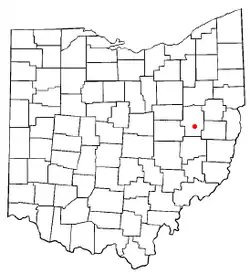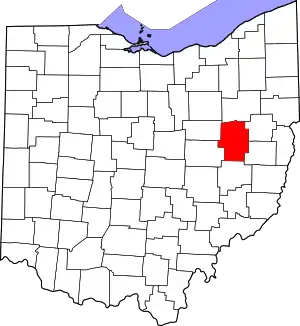Gnadenhutten, Ohio
Gnadenhutten (/ʒəˈneɪdənhʌtən/ zhə-NAY-dən-hut-ən) is a village located on the Tuscarawas River in Tuscarawas County, Ohio, United States and is Ohio's oldest existing settlement. The population was 1,288 at the 2010 census.
Gnadenhutten, Ohio | |
|---|---|
 Monument at the massacre site | |
 Location of Gnadenhutten, Ohio | |
 Location of Gnadenhutten in Tuscarawas County | |
| Coordinates: 40°21′39″N 81°25′54″W | |
| Country | United States |
| State | Ohio |
| County | Tuscarawas |
| Townships | Clay, Warwick, & Rush |
| Government | |
| • Mayor | Richard Gilmore [1] |
| Area | |
| • Total | 0.96 sq mi (2.50 km2) |
| • Land | 0.96 sq mi (2.50 km2) |
| • Water | 0.00 sq mi (0.00 km2) |
| Elevation | 837 ft (255 m) |
| Population | |
| • Total | 1,288 |
| • Estimate (2019)[5] | 1,258 |
| • Density | 1,303.63/sq mi (503.57/km2) |
| Time zone | UTC-5 (Eastern (EST)) |
| • Summer (DST) | UTC-4 (EDT) |
| ZIP code | 44629 |
| Area code(s) | 740, 330 |
| FIPS code | 39-30702[6] |
| GNIS feature ID | 1064736[3] |
History
Gnadenhutten was founded in October 1772 as the second settlement of German Americans and Lenape Indians affiliated with the Moravian Church.[7] Tribes of Christianized Lenni Lenape people had settled at Schoenbrunn nearby, founded months earlier by missionary David Zeisberger. On July 4, 1773, a baby boy was born to the Roth family, becoming the first white child known to be born in the Ohio territory.[8] This community, originally led by the Christianized Mohican chieftain Joshua (who died August 1 of the following year), had grown to about 200 persons by 1775.
As pacifists, they remained neutral during the American Revolution and subsequent Revolutionary War. However, the British and their Indian Wyandot and Delaware allies suspected that members of the Christian Gnadenhutten, Schoenbrunn, and Salem communities had provided aid to American patriots. As a result, the Wyandot and Delaware forced the Lenape tribespeople in the region to the Upper Sandusky area of the Ohio territory. While the British detained Rev. Zeisberger at Fort Detroit, they allowed roughly one hundred and fifty Lenape to return to their old town to gather the harvest and supplies stored there. However, Pennsylvania militiamen, led by David Williamson, following the murder of American settlers by other Indian tribes a few weeks earlier, came to the resettled town in March 1782, and tricked the Indians into giving up their weapons. Ninety-six innocent Lenape men, women, and children spent the night in song and prayer knowing they would be slaughtered the following morning. On March 8 the Pennsylvanians committed the Gnadenhutten massacre and burned the approximately 60-cabin town. Only two boys escaped; the incident led to distrust between Native Americans and American settlers, and reprisals against American patriots in Native American custody.[9][10]
Although three 4,000 acre tracts were reserved for Indians as an "act of indemnity",[11] John Ettwein petitioned Congress in 1783 and the area was then opened to European American settlers. John Heckewelder from Pennsylvania built the first house in 1798, and Moravians remain in the town today. Few Native Americans chose to live there and they gave up title in 1823 after the Moravians had made many improvements.
Gnadenhutten was on a major wagon road crossing the Tuscarawas River. The first Ohio Canal was dug nearby in 1825-1830, providing access to markets as well as further immigrants via Cleveland. A railroad linked to the area in 1853, further improving market access and allowing industrial development. A flood in 1915 destroyed the canal, which was not rebuilt as other means of transportation had superseded it.[9]
Gnadenhutten erected a monument to the martyrs of the March 8, 1782 massacre during the centennial of its founding, and in 1963 established a museum interpreting it and other aspects of the town's history (including the results of 1970 excavations, and having rebuilt the Mission House and Cooper shop, and erected a mound containing the martyrs' graves).[9] Various Native American and First Nations people gathered at the site in 1988 to dedicate a peace tree. The State of Ohio erected a memorial marker in 2003, calling the event a "day of shame"; it had erected another historical marker shortly before the town's entrance in 1979.[12]
The Moravians rebuilt their church in 1903 and dedicated it as a memorial to John Heckewelder. The village also has a Masonic Temple (built 1855 and rebuilt), Methodist church (built circa 1910), as well as a Church of Christ and Full Gospel Pentecostal Church on the outskirts.[13] Its current library was erected in 1942.
Events
Gnadenhutten is known for its Fourth of July celebration, featuring horse-drawn carriages and fireworks. It also celebrates its Pioneer Days on the first weekend in August and an Apple Butter festival the second weekend of October. Its Native American heritage continues to be marked with its "Indian Valley" moniker and a Christian Indian Christmas Drive-Thru Display Thanksgiving through December.[14]
Name
Gnadenhutten is derived from the German name Gnadenhütten (German: [gnaːdn̩hʏtn̩]),[15] meaning literally "huts of grace" and figuratively "log tabernacle".[16] Gnadenhutten was declared the "most difficult to pronounce" place name in the state of Ohio by Reader's Digest.[17]
Geography
Gnadenhutten is located at 40°21′39″N 81°25′54″W (40.360815, -81.431679).[18] According to the United States Census Bureau, the village has a total area of 0.97 square miles (2.51 km2), all land.[19]
Demographics
| Historical population | |||
|---|---|---|---|
| Census | Pop. | %± | |
| 1870 | 284 | — | |
| 1880 | 336 | 18.3% | |
| 1890 | 478 | 42.3% | |
| 1900 | 547 | 14.4% | |
| 1910 | 560 | 2.4% | |
| 1920 | 530 | −5.4% | |
| 1930 | 870 | 64.2% | |
| 1940 | 876 | 0.7% | |
| 1950 | 895 | 2.2% | |
| 1960 | 1,257 | 40.4% | |
| 1970 | 1,466 | 16.6% | |
| 1980 | 1,320 | −10.0% | |
| 1990 | 1,226 | −7.1% | |
| 2000 | 1,280 | 4.4% | |
| 2010 | 1,288 | 0.6% | |
| 2019 (est.) | 1,258 | [5] | −2.3% |
| U.S. Decennial Census[20] | |||
2010 census
As of the census[4] of 2010, there were 1,288 people, 509 households, and 359 families living in the village. The population density was 1,327.8 inhabitants per square mile (512.7/km2). There were 553 housing units at an average density of 570.1 per square mile (220.1/km2). The racial makeup of the village was 99.1% white, 0.2% from other races, and 0.7% from two or more races. Hispanic or Latino of any race were 0.5% of the population.
There were 509 households, of which 35.0% had children under the age of 18 living with them, 60.3% were married couples living together, 6.7% had a female householder with no husband present, 3.5% had a male householder with no wife present, and 29.5% were non-families. 25.7% of all households were made up of individuals, and 14.2% had someone living alone who was 65 years of age or older. The average household size was 2.52 and the average family size was 3.05.
The median age in the village was 39.3 years. 25.6% of residents were under the age of 18; 6.7% were between the ages of 18 and 24; 26.2% were from 25 to 44; 24.3% were from 45 to 64; and 17.4% were 65 years of age or older. The gender makeup of the village was 49.5% male and 50.5% female.
2000 census
As of the census[6] of 2000, there were 1,280 people, 513 households, and 377 families living in the village. The population density was 1,281.7 people per square mile (494.2/km2). There were 539 housing units at an average density of 539.7 per square mile (208.1/km2). The racial makeup of the village was 99.45% white, 0.08% African American, and 0.47% from two or more races. Hispanic or Latino of any race were 0.16% of the population.
There were 513 households, out of which 30.4% had children under the age of 18 living with them, 62.8% were married couples living together, 7.6% had a female householder with no husband present, and 26.5% were non-families. 24.2% of all households were made up of individuals, and 14.6% had someone living alone who was 65 years of age or older. The average household size was 2.49 and the average family size was 2.94.
In the village, the population was spread out, with 23.8% under the age of 18, 8.9% from 18 to 24, 26.5% from 25 to 44, 21.5% from 45 to 64, and 19.4% who were 65 years of age or older. The median age was 39 years. For every 100 females there were 86.9 males. For every 100 females age 18 and over, there were 83.8 males.
The median income for a household in the village was $34,286, and the median income for a family was $38,000. Males had a median income of $32,026 versus $20,526 for females. The per capita income for the village was $15,961. About 9.3% of families and 8.8% of the population were below the poverty line, including 12.0% of those under age 18 and 4.1% of those age 65 or over.
Notable people
- Bob Huggins - men's college basketball coach at West Virginia University, former men's college basketball coach at University of Cincinnati and Kansas State University
- Eldon Miller - former men's college basketball coach at Wittenberg University, Western Michigan University, Ohio State University, and the University of Northern Iowa
References
- https://lookup.boe.ohio.gov/files/tuscarawas/results.pdf
- "2019 U.S. Gazetteer Files". United States Census Bureau. Retrieved July 28, 2020.
- "US Board on Geographic Names". United States Geological Survey. 2007-10-25. Retrieved 2008-01-31.
- "U.S. Census website". United States Census Bureau. Retrieved 2013-01-06.
- "Population and Housing Unit Estimates". United States Census Bureau. May 24, 2020. Retrieved May 27, 2020.
- "U.S. Census website". United States Census Bureau. Retrieved 2008-01-31.
- http://www.ohiohistorycentral.org/w/Gnadenhutten
- http://www.gnaden.com/?cat=4
- "Archived copy" (PDF). Archived from the original (PDF) on 2013-01-21. Retrieved 2015-04-28.CS1 maint: archived copy as title (link)
- "Gnadenhütten Massacre". History. 21 August 2018. Retrieved 15 October 2020.
- http://gettingjeffersonright.com/gnadenhuttenmassacre/ citing THE AMERICAN FAMILY OF REV OBADIAH HOLMES BY COL JT HOLMES, (Columbus, Ohio: Stoneman Press, 1915
- http://www.waymarking.com/waymarks/WM6HN0_Gnadenhutten_The_Gnadenhutten_Massacre_Day_of_Shame_15_79
- http://www.gnaden.com/?cat=12
- http://www.gnaden.com/
- Gnade (the German for grace); a word with which the names of many places founded by the Moravians begin, Encyclopædia Americana, 1831
- Gannett, Henry (1905). The Origin of Certain Place Names in the United States. Govt. Print. Off. pp. 139.
- Cahn, Lauren. "The Most Difficult-to-Pronounce Town in Every Single State". Reader's Digest. Archived from the original on 26 June 2019. Retrieved 7 July 2019.
- "US Gazetteer files: 2010, 2000, and 1990". United States Census Bureau. 2011-02-12. Retrieved 2011-04-23.
- "US Gazetteer files 2010". United States Census Bureau. Archived from the original on 2012-01-25. Retrieved 2013-01-06.
- "Census of Population and Housing". Census.gov. Retrieved June 4, 2015.
